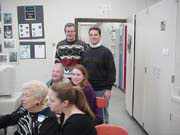About 35 of the town’s senior citizens climbed off the buses in front of Secaucus High School on a bright morning last month and made their way through the building’s glass doors.
This was a Saturday morning, so no students buzzed through the halls, although a small crowd of students from the school’s technology club waited on the large concrete sidewalk as each senior citizen exited the bus.
While seniors are not an uncommon sight in the halls of the high school, senior citizens are. But this was the second year in a row that a group of the town’s elderly made the trek as part of the school’s district’s effort to bring old and young together.
Each senior citizen was greeted by two students – called student-instructors – who led them into the school’s cafeteria for morning orientation.
The elderly and the young got to know each other a little over tea and coffee before venturing to other parts of the large building to do some surfing – surfing the Internet, that is.
High School Principal Patrick Impreveduto welcomed the guests, looking out over the two-dozen round tables from which old and young faces stared back.
Technological literacy
The event was sponsored by the American Technology Honor Society and Club, whose mission is to promote and recognize in students technological literacy, including the creative and responsible use of technology; scholarship; commitment to service; and leadership. By having students help senior citizens to use the computers, the theory goes, these students will enhance their own skills. The students also help bring the community together through a kind of mentoring program.
The event was started in October, 1999, when the school brought the senior citizens to the high school to surf the Internet for the first time.
Virginia Foley, the American Technology Honor Club’s advisor, had encouraged Principal Impreveduto to create the opportunity for students to meet senior citizens through a common interest. Foley, a teacher at the high school since 1975, is currently a mathematics and computer science teacher.
“After we told the senior [citizens] what we planned to do, we took them to our computer labs,” said Impreveduto, noting that the school had set aside three of the labs for the project. “Our students helped them surf the Internet.”
For 90 minutes, the seniors got to explore the Internet, send e-mail to friends and relatives and create documents using the computer layout programs and computers. The seniors sought out information on travel, health, cars, dolls, gardening and other areas of interest.
“They were extremely grateful,” Impreveduto said. “They kept saying how great it was to talk to their sons or daughters or grandchildren, some of whom didn’t get to visit the senior citizens much.”
Just as important, said Foley, were the conversations that took place between senior citizens and their student guides, which seemed to bond the generations together.
“The senior citizens were overwhelmingly pleased,” Impreveduto said. “If fact, they want to do it more often.”
Getting technology into the schools
In 1996, just after Impreveduto had been appointed middle school principal and before his eventual promotion to the position of principal of the high school, he did an unofficial survey of the school’s technology. He was shocked to find the schools out of touch with the technological revolution. Impreveduto found that the most abundant computer in the whole Secaucus system was the Apple IIe, which by contemporary standards is about as out-of-date as the Model T Ford, leaving most Secaucus students to putt along the information superhighway while students from other school districts zoomed past.
As media coordinator for the school system since 1992, Impreveduto had previously thought that Secaucus was well on its way to modernizing its computer base. In fact, in 1994, Impreveduto was instrumental in helping develop Renaissance 2000, a technology plan that would put the school district into the 21st Century, providing its students with all the tools they would need to get jobs in the real world. But in 1995, voters rejected the school district’s $10.9 million bond proposal – part of which was designed to fund this technology project.
Eventually, with the help of the School Board and Charlotte Podesta – Impreveduto’s replacement as middle school principal when he was promoted the high school – the district caught up with the real world. Over the last three years, the school district has modernized each and every school, and most recently established an inter-school network that allows for whole new ways of teaching.
In some ways, reaching out to the senior citizens is a way of sharing the wealth with the community, Impreveduto said, allowing these residents to understand firsthand what the investment in technology was all about.
“What we’re doing is giving the senior citizens the opportunity to learn the Internet,” Impreveduto said.
